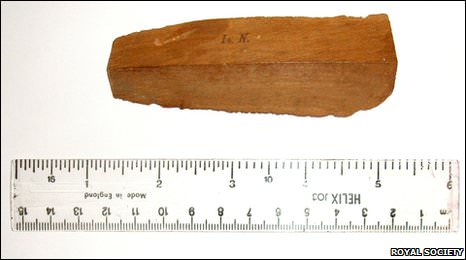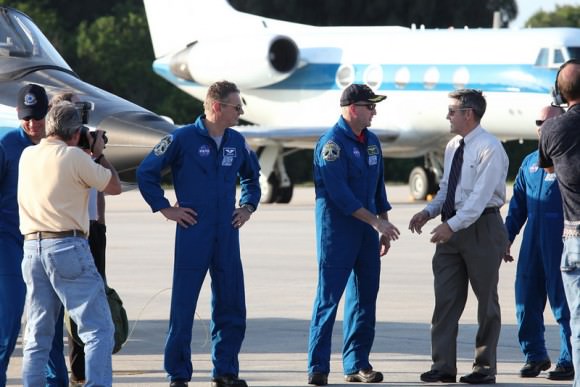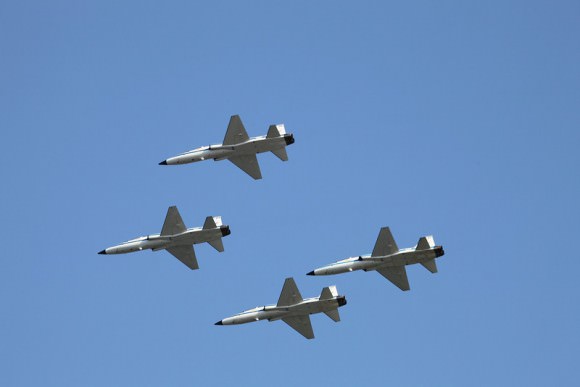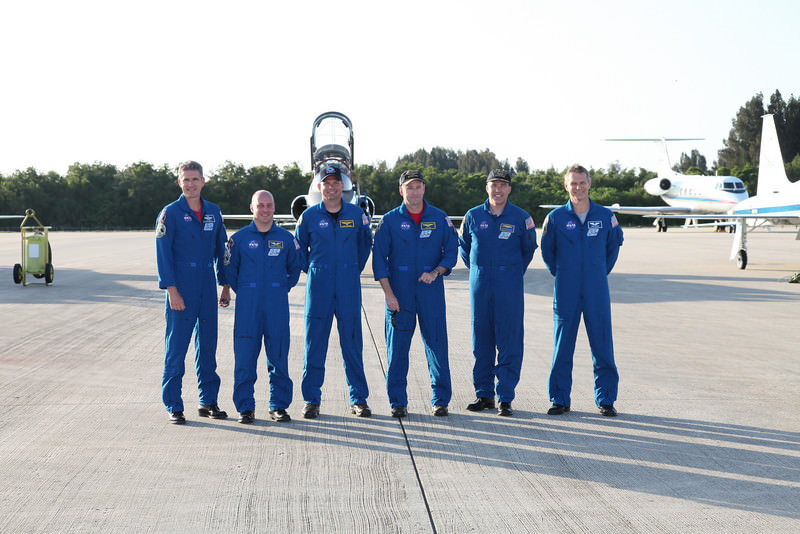[/caption]
As the space shuttle crew arrived at Kennedy Space Center for Thursday’s scheduled launch of the STS-132 mission, already on board space shuttle Atlantis is a piece of physicist Sir Isaac Newton’s apple tree. A 4-inch-long wood sample from the original tree that supposedly inspired Newton’s theory of gravity, along with a picture of Newton, will be taken into orbit by British-born astronaut Piers Sellers, a member of the crew for this next mission to the International Space Station. The wood is part of the collection of the Royal Society archives in London, and will be returned there following the flight. “We’re delighted to take this piece of Sir Isaac Newton’s apple tree to orbit,” said Sellers in an article from AFP. “While it’s up there, it will be experiencing no gravity, so if it had an apple on it, the apple wouldn’t fall.”
*Of course, that is not quite correct.
The piece of Newton’s tree is will still be experiencing gravity, and in fact, will be falling the entire time it is in orbit. It will be in free fall along with the shuttle and space station as it orbits the Earth. A free-falling object falls under the sole influence of gravity, and in the case of the shuttle (or any object in orbit), its orbital motion keeps it moving fast enough that it doesn’t fall back to Earth — unless its acceleration changes.

“We are both pleased and proud that such an extraordinary part of scientific history and important element of the Royal Society’s archive collection can make this historic trip into space,” said Lord Rees, the current president of the Royal Society. “Upon their return the piece of tree and picture of Newton will form part of the History of the Royal Society exhibition that the Society will be holding later this year and will then be held as a permanent exhibit at the Society.”
The Royal Society is celebrating its 350th anniversary. Newton was president of the Society from 1703 until his death in 1727.
“I’m pretty sure that Sir Isaac would have loved to see this, assuming he wasn’t spacesick, as it would have proved his first law of motion to be correct,” Sellers said.

Launch is targeted for 2:20 p.m. EDT on May 14. This is the last scheduled flight for Atlantis before the shuttle program ends.
Just as the astronauts arrived at KSC at about 7 pm EDT, over at Launch Pad 39A, technicians were performing vertical closeouts for Atlantis and its payload which includes — besides the piece of the tree — an Integrated Cargo Carrier and a Russian-built Mini Research Module, to be delivered to the International Space Station during the 12-day mission.
At 4 p.m. EDT on Tuesday, May 11, countdown clocks across the launch site will begin ticking away the hours leading to liftoff. The countdown will begin at the T-43 hour mark following the traditional call-to-stations for launch controllers.
In addition to Sellers, the crew includes Commander Ken Ham, Mission Specialists Garrett Reisman, Steve Bowen and Michael Good, and Pilot Tony Antonelli.

*thanks to Dave Chapman and others for the addition/correction to the article.


I would also like to include that other Ken Ham (the creationist nutcase) and send him off into deep space — permanently!
(First, I hope the quote works…!)
But I’m surprised this was said by an astronaut. As we all know, the apple is still experiencing gravity, and it is permanently falling.
Exactly right. Shouldn’t somebody stop Mr Sellers and play him “AstronomyCast 181: Rotation” before he takes off and attempts to disprove Sir Isaac?
Depending on your reference frame, Mr Sellers statement “the apple wouldn’t fall” is not strictly correct. If there was no “fall” (acceleration towards Earth) then Mr Sellers and his tree sample would zoom off into space in a straight line (Newton’s 1st law). Instead they fall and translate to the net effect of flying a nearly circular orbit.
The Royal Society’s self promotion in the fashion of Clyde Tombaugh’s ashes aboard New Horizons or Gene Roddenberry’s ashes being launched to LEO etc… might be understandable, but who and what is next? One of Einstein’s tobacco pipes or maybe Von Braun’s old slide rule?
Wouldn’t it be more worthwhile concentrating on growing and experimenting with living plants on the ISS as research into a sustainable food source for the upcoming long duration space flights?
If the human space flight program wants to capture imaginations, then please do it with new, exciting, far reaching and scientifically useful results. This is what we look for when we invest our dollars in space.
Enjoy your $1.5 bn ride guys.
Wasn’t that whole apple story a modern-day fable anyway?
Yeas, it’s the old “micro-gravity” sometimes misnomer all over again.
The more egregious mistake may be the piece of wood, as it seems the whereabouts of the original tree itself are unknown. But perhaps someone saved a piece in time.
@ TerryG: To be fair, even though the ISS hasn’t been manned for research until a year ago, it has racked up quite a record of science. But since the main research period is still in its infancy, it is likely easier to use publicity stunts than to discuss ongoing projects.
In most cases it takes years for science programs to start to deliver results, no one would knock on the doors of a one year truly manned, not yet completed. facility and demand hard results. Well, except for the ISS of course, as it seems normal conditions doesn’t apply. Emotional reasons, at a guess.
I read on the ISS research that during construction still 138 experiments were made and ~ 200 papers were written up to 2008. That is impressive considering the circumstances, with a few man hours every day put into it.
NASA has indeed reported some “new, exciting, far reaching and scientifically useful results”. The later link above summarizes that too. For example, the discovery that space conditions increase virulence of pathogens. This is of course far reaching for space exploration and colonization as well as understanding earthly diseases, and a new area of research that they by now would concentrate on.
I thought it was an urban myth too, but sources like Wikipedia gives references that Newton himself said thusly, that must be checked. That is, the apple tree and its falling apple example seems legit, not the apple-on-the-head story.
My initial reaction is that the apple is a bit much tied into some religions obsession with it as a symbolic “fruit of knowledge”. But then I remembered that Newton himself was likewise tied into same post-semitism.
Perhaps disregarding the apple tree altogether would be to propagate another urban myth. 🙂
tek_604 you are technically correct; the best kind of correct.
I dislike the term “micro-gravity” too. Your still falling, just taking the scenic route.
As the space shuttle crew arrived at Kennedy Space Center for Thursday’s scheduled launch of the STS-132 mission, already on board space shuttle Atlantis is a piece of physicist Sir Isaac Newton’s apple tree.
Launch is targeted for 2:20 p.m. EDT on May 14. This is the last scheduled flight for Atlantis before the shuttle program ends.
Thursday is the 13th, not the 14th. Is it scheduled for the 13th or the 14th?